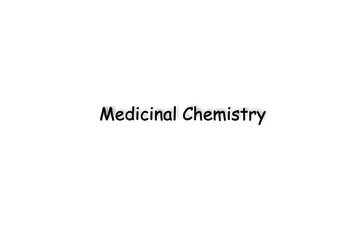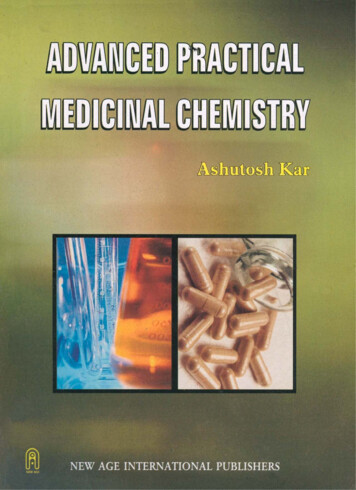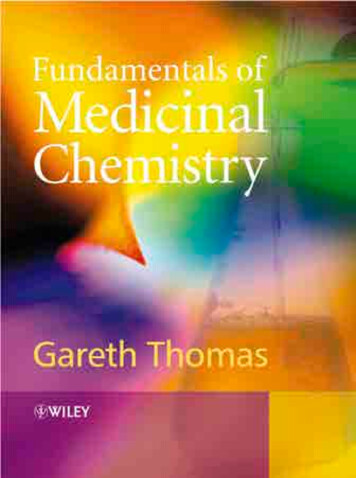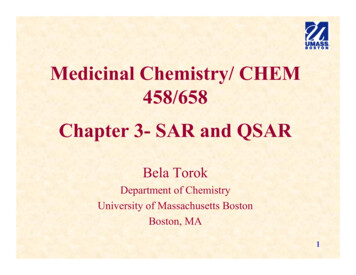
Transcription
MEDICINAL CHEMISTRYUnit IPrepared By:Neetu SabarwalDepartment of PharmaceuticalChemistrySOS Pharmaceutical SciencesJiwaji University. Gwalior1
2
DEFINITION: Theabilityofa chemical compoundtoelicitapharmacological/therapeutic effect is related to the influence of variousphysical and chemical (physicochemical) properties ofthe chemical substance on the bio molecule that itinteracts with.1)Physical PropertiesPhysical property of drug is responsible for its action2)Chemical PropertiesThe drug react extracellularly according to simplechemical reactions like neutralization, chelation, oxidation etc
Physico-chemical properties in relation tobiological actionDrug action results from the interaction of drug molecules with eithernormal or abnormal physiological processes.Drugs normally interact with targets (which they are proteins, enzymes,cell lipids, or pieces of DNA or RNA).The ability of a chemical compound to elicit a pharmacologic/therapeutic effect is related to the influence of its various physical andchemical (physicochemical) properties4
Various Physico-Chemical Properties are, Ionization of Drug Solubility Partition Coefficient Hydrogen Bonding Protein binding Chelation Bioisosterism Geometrical and optical isomerism5
Ionization of drug Most of the drugs are either weak acids or baseand can exist in either ionised or unionised state. Ionization Protonation or deprotonationresulting in charged molecules. The ionization of the drug depends on its pKa &pH. The rate of drug absorption is directlyproportional to the concentration of the drug atabsorbable form but not the concentration of thedrug at the absorption site.6
Ionization form imparts good water solubilityto the drug which is required of binding ofdrug and receptor interaction Unionized form helps the drug to cross the cellmembrane. Eg; Barbituric acid is inactive because it isstrong acid. while, 5,5 disubstitutedBarbituric acid has CNS depressant actionbecause it is weak acid.7
SOLUBILITY OF ORGANIC MEDICINALAGENTSImportance of solubility:(1) Formulation of the drug in an appropriate dosageform and(2) Bio- disposition: Disposition of drugs in the livingsystem after administration ( absorption, distribution,metabolism, and excretion).The solubility expression: in terms of its affinity/philicity orrepulsion/phobicity for either an aqueous (hydro) or lipid (lipo)solvent.
hydrophilic. water loving lipophobic. lipid hating lipophilic. lipid loving hydrophobic. water hating7
8
9
SOLUBILITYOF ORGANIC MEDICINAL AGENTSIn order for a chemical compound to dissolve in a particularsolvent/medium the compound must establish attractive forcesbetween itself and molecules of the solvent.It is possible to estimate the solubility properties of an OMA(hydrophilic vs. lipophilic) by examining the structure of thedrugs and noting whether its structural features promoteaffinity for aqueous or lipid media.The most important intermolecular attractive forces (bonds)that are involved in the solubilization process are:10
The most important intermolecular attractive forces (bonds):that are involved in the solubilization process are1. Van der Waals Attraction weakest intermolecular force (0.5-1.0 kcal/mole) electrostatic occurs between nonpolar groups (e.g. hydrocarbons) highly distance and temperature dependent2. Dipole- Dipole Bonding stronger (1.0 to 10 kcal/mole) occurs electrostatically between electron deficient and electronexcessive /rich atoms (dipoles) hydrogen bonding is a specific example of this bonding and serves as aprime contributor to hydrophilicity O H OH ON:C H HO H11
3. Ionic Bonding electrostatic attraction between cations and anions common in inorganic compounds and salts of organicmolecules relatively strong (5 kcal/mole)ON -NaCH Cl -O4. Ion-Dipole Bonding electrostatic between a cation/anion and a dipole relatively strong (1-5 kcal/mole) low temperature and distance dependence important attraction between OMAs and H2OHO N H HOCH-O OH12
Solubility Prediction The relative solubility of a drug is a function ofthe presence of both lipophilic and hydrophilicfeatures within its structure, which serve todetermine the extent of interaction of the OMA withlipid and/or aqueous phases. The relative solubility of a drug can bedetermined in the laboratory, i.e. the partitioncoefficient [P; the ratio of the solubility of thecompound in an organic solvent to the solubility ofthe same compound in an aqueous environment(i.e., P [Drug]lipid/ [Drug]aqueous). P is oftenexpressed as a log value.13
Solubility PredictionA mathematical procedures also have beendeveloped to estimate the relative solubility of anorganic molecule based upon differentialcontributions of various structural features to overallsolubility.For example, the relative solubility of a drug is thesum of the contributions of each group andsubstituent to overall solubility.Example:Examination of the structure of chloramphenicol(indicates the presence of both lipophilic (nonpolar)and hydrophilic (polar) groups and substituents.14
Solubility icOHO2NOCH CHNHCCHCl2CH2OHChloramphenicolHydrophilicThe presence of oxygen and nitrogen containing functional groupsusually enhances water solubility. While lipid solubility is enhanced bynonionizable hydrocarbon chains and ring systems.15
Solubility Prediction1.Laboratory Estimation of Relative SolubilityThe relative solubility of an organic compound is measured by determining theextent of its distribution into an aqueous solvent (usually pH 7.4 buffer) and alipid solvent (usually n-octanol). These experiments generate a value, P, thepartition coefficient for that particular compound.Conc. of compunds in C8H16OHPartition coefficient Conc. of compunds in H2O1816
19
31
32
33
34
35
36
37
38
39
40
41
NEXT 4 PHYSICOCHEMICAL PROPERTIESWILL BE DISCUSSED TOMORROW IN NEXTPPT42
The ability of a chemical compound to elicit a pharmacological/ therapeutic effect is related to the influence of various physical and chemical (physicochemical) properties of the chemical substance on the bio molecule that it interacts with. 1)Physical Properties Physical property of drug is responsible for its action .










